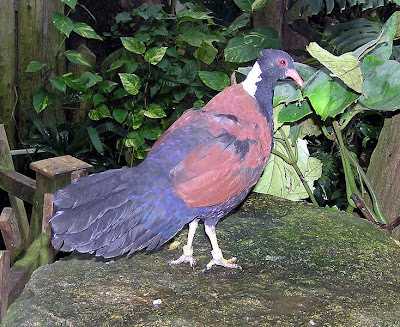The pheasant pigeon is an unusual pigeon of uncertain affinities within the Columbidae, and is monotypic within the genus Otidiphaps (Gould, 1870), and the sub-family Otidiphabinae. Its scientific name makes reference to its similarities to the bustard family (Otidae). Its common name reflects its adaptation to living on the forest floor in the fashion of a South East Asian pheasant, which it resembles in external morphology, particularly in its laterally compressed tail and the rounded wings. No galliform birds occur in New Guinea, and the pheasant pigeon has filled the ecological niche of a partridge or small pheasant (while the larger Goura crowned pigeons have a lifestyle similar to larger pheasants, grouse or turkeys). It is a highly secretive species, feeding on seeds and fallen fruits. It nests on the ground below trees and bushes, laying one egg that it incubates for around 4 weeks.
There are four subspecies, which differ primarily in the presence or absence of a small crest and in the colour of the nape. The two best known are the western nominate (O. n. nobilis) with a greenish nape and O. n. aruensis from the Aru Islands with a white nape. The two remaining subspecies, O. n. cervicalis from the eastern part of its range and O. n. insularis from Fergusson Island, have a grey nape and a black nape (concolour with the remaining black neck) respectively.
It is not considered threatened, although it has become locally extinct in some areas. Because it is tied to primary forests, and is unique within the pigeon family, it is considered a species that requires further investigation and monitoring.

No comments:
Post a Comment